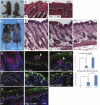Quantitative functions of Argonaute proteins in mammalian development
- PMID: 22474261
- PMCID: PMC3323880
- DOI: 10.1101/gad.182758.111
Quantitative functions of Argonaute proteins in mammalian development
Abstract
Argonaute proteins (Ago1-4) are essential components of the microRNA-induced silencing complex and play important roles in both microRNA biogenesis and function. Although Ago2 is the only one with the slicer activity, it is not clear whether the slicer activity is a universally critical determinant for Ago2's function in mammals. Furthermore, functional specificities associated with different Argonautes remain elusive. Here we report that microRNAs are randomly sorted to individual Argonautes in mammals, independent of the slicer activity. When both Ago1 and Ago2, but not either Ago1 or Ago2 alone, are ablated in the skin, the global expression of microRNAs is significantly compromised and it causes severe defects in skin morphogenesis. Surprisingly, Ago3 is able to load microRNAs efficiently in the absence of Ago1 and Ago2, despite a significant loss of global microRNA expression. Quantitative analyses reveal that Ago2 interacts with a majority of microRNAs (60%) in the skin, compared with Ago1 (30%) and Ago3 (<10%). This distribution is highly correlated with the abundance of each Argonaute, as quantified by shotgun proteomics. The quantitative correlation between Argonautes and their associated microRNAs is conserved in human cells. Finally, we measure the absolute expression of Argonaute proteins and determine that their copy number is ~1.4 × 10(5) to 1.7 × 10(5) molecules per cell. Together, our results reveal a quantitative picture for microRNA activity in mammals.
Figures







References
Publication types
MeSH terms
Substances
Grants and funding
LinkOut - more resources
Full Text Sources
Other Literature Sources
Molecular Biology Databases
